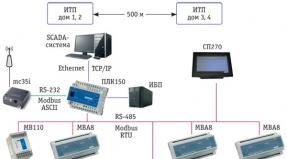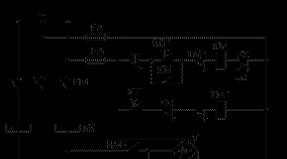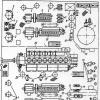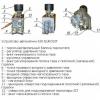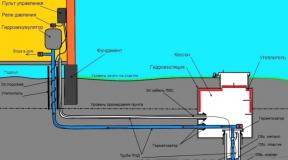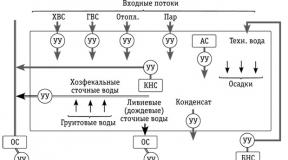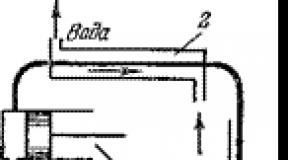The main amount of iron in the human body is absorbed. Absorption of iron in the intestine. Treatment process: what to do
Iron is one of those nutrients, the absorption of which is highly dependent on the foods eaten in one meal.
You can eat a food that contains a lot of iron, but it will not be absorbed if a substance that blocks absorption is consumed in the same meal. Conversely, you can eat relatively little iron, but with the use of absorption stimulants, the body will receive the substance in full.
In other words, the absorption of iron directly depends on its solubility in the intestine, and this, in turn, is determined by the composition of the food eaten at one meal.
Let us give general table of substances that accelerate or inhibit the absorption of iron, and then we will consider in detail what this influence is connected with.
| Products and substances BRAKING iron absorption |
Products and substances ACCELERATING iron absorption |
||||
| Products | The degree of influence | Active substance | Products | The degree of influence | Active substance |
| whole grains, corn | --- | phytate | liver / meat / fish | +++ | "meat factor" |
| tea, green leafy vegetables | --- | polyphenols | orange, pears, apples | +++ | vitamin C |
| milk, cheese | -- | calcium plus phosphate | plums, bananas | ++ | vitamin C |
| spinach | - | polyphenols, oxalic acid | cauliflower | ++ | vitamin C |
| egg | - | phosphoprotein, albumin | tomatoes, green peppers, cucumbers | + | vitamin C |
| carrots, potatoes, beets, pumpkin, broccoli, tomatoes, cabbage | ++ | lemon, apple, tartaric acid | |||
| kefir, sauerkraut | ++ | acid | |||
Source:
British Nutrition Foundation. Iron: nutritional and physiological significance. Report of the British Nutrition Foundation Task Force. London, Chapman & Hall.
Vitamin C stimulates iron absorption
Vitamin C is the strongest activator of iron absorption. This is due to the ability of ascorbic acid to increase its solubility and form soluble compounds.How to reduce the blocking effect of phytates on iron absorption
Phytates are a form of storage of phosphates and minerals found in cereals, vegetables, seeds, and nuts. They are one of the strongest substances that block the absorption of iron and even a small amount can make all the iron eaten at a given meal inaccessible.Fortunately, there are a number of simple methods that can help lower phytate levels:
- fermentation,
- germination,
- grinding,
- soaking,
- roasting.
Soaking and sprouting promotes the breakdown of phytate in cereals and legumes.
Polyphenols block iron absorption
Phenolic compounds exist in almost all plants and are part of their insect and animal defense systems. Several phenolic compounds bind iron and thus inhibit its absorption. These compounds are contained in- coffee,
- cocoa,
- in many vegetables, several herbs, spices.
Such a strong effect allows even the use of tea in the form of a medicine to treat iron overload.
Unfortunately, you can often see how mothers, not drinking tea, give a small child this drink at an extremely early age, and even babies. This can contribute significantly to the development of iron deficiency.
At birth, there are many reserves of iron, but they are depleted in the first 6 months of life, and then the baby is completely dependent on getting this element from food.
Iron stores can be assessed by measuring serum ferritin levels.
The body regulates iron absorption based on reserves
Iron is one of those vital nutrients that the body can store.This is very important to remember, and if at certain times you consume a lot of iron (good apple harvest, apple fasting days, etc.), then you need to reduce your iron intake for a certain period.
Nature has created our body very intelligent, it is able to regulate absorption with a large amount of reserves. It is extremely dangerous to consider some mineral, vitamin "useful" and try to eat it as much as possible. The body needs everything exactly in the amount it needs. If you don’t need it anymore, but you continue to saturate the body with an element that is NOT already needed, then this inevitably leads to health problems.
Excessive iron intake increases the risk of:
- infections,
- cardiovascular diseases,
- non-insulin-dependent diabetes,
- cancer.
In addition, high iron intake can interfere with the absorption of copper and zinc. these 3 minerals share the same absorption mechanism.
You can determine how much iron you need to consume per day in
All the "irreplaceable" iron losses described above are compensated by absorption from food. If the process of iron loss in some pathological or "borderline" conditions is uncontrolled, then iron absorption is regulated. At the same time, limitation of the absorption of this element from food is carried out according to two principles - the principle of safety and the principle sufficiency... The latter of them is underestimated, and the key points of iron metabolism (first of all, the mechanisms of limiting its entry into the body) are explained only by the toxicity of iron and the body's desire to protect itself from excessive intake of this vital, but also dangerous trace element into the bloodstream and tissues. However, even this characteristic of iron as a vital trace element makes one skeptical about this principle of safety as the only one that “guided” evolution in the process of forming mechanisms for supplying iron to the human body (as, probably, any other).
Sufficiency principle, how to conserve biological resources, is no less important for the rational construction of various systems of living. And it, as will be shown below, also acts in the formation of mechanisms for the entry of iron into the body.
The main amount of iron (about 90%) is absorbed in the duodenum, the rest - in a small area of \u200b\u200bthe upper jejunum. 1% of iron can be absorbed in the stomach. Studies with radioactive isotopes of iron have shown that the entire small intestine is capable of absorbing the element in a minimum volume, and even the thick one in trace amounts. Moreover, with iron dysfunction, the bridgehead of active absorption of iron in the upper part of the small intestine expands, but it is insignificant and does not play a significant role in increasing the intake of this element into the body, even with a pronounced deficiency. An increase in the intake of iron during iron deficiency occurs mainly due to an increase in its absorption in the above-mentioned parts of the intestine -
12 duodenum and upper jejunum. This issue is currently well studied and can be considered fundamentally resolved.
However, the intimate mechanism of absorption, despite its intensive study, remains not fully understood and to some extent hypothetical. There is an assumption that iron is captured by special cells found in the duodenum. But, in general, the entire intestinal epithelium is involved in this process. In this case, the capture of iron is carried out not according to the principle of physical adsorption, but rather active absorption by the brush border of the cells. This process is fast. Within 5-20 minutes after the introduction of iron into the gastrointestinal tract, significant amounts of iron are found in the brush border and mitochondria of cells. Trivalent (oxide - Fe 3+) iron is practically unable to be absorbed. It is converted in the intestinal lumen into bivalent (ferrous - Fe 2 +) and in this form enters the membrane of microvilli, where it is again converted into oxide, which is further metabolized. However, there is little ionized iron in food, and it is a part of various compounds, primarily heme. In addition, iron contains other compounds, mainly ferritin and hemosiderin. The most actively absorbed heme iron is found in the greatest amount in meat products. In this case, the heme entirely comes from the intestinal lumen into the cellular cytoplasm of the epithelium and there, with the participation of the enzymes heme oxygenase and xanthine oxidase, it is split into bilirubin, carbon monoxide and ionized iron. Further metabolism of this iron is not entirely clear. It was hypothesized that it binds to intracellular apoferritin, which acts as a "trap" for iron, possibly with the help of intracellular apotransferrin, and transfers it across the basement membrane of cells into plasma, where it is immediately bound by plasma transferrin. At the same time, there is a certain ratio between apoferritin and apotransferrin, free of iron, and ferritin and transferrin associated with it. However, this hypothesis has not found experimental confirmation.
Heme can enter the plasma unchanged, but in small quantities, and be transferred to the liver. It is believed that the process of iron absorption includes 3 stages - the entry of iron into the intestinal mucosa, the accumulation of storage iron in the cytoplasm and the effect of these reserves (according to the feedback principle) on iron absorption and, finally, the penetration of iron from the cell into the plasma. However, the intimate mechanisms of this process have not been studied. The mechanisms regulating the increase or decrease in iron absorption are also unclear. Attempts to find humoral regulatory factors were unsuccessful, although some experimental data make it possible to speak with confidence about their existence. It has been established that a decrease in iron stores leads to an increase in its absorption from the intestine. The same, although in a less pronounced form, is observed with an increase in erythropoiesis or an increase in the level of erythropoietin in the blood with normal iron stores. The regulator of the entry of iron from the intestinal epithelium into the plasma is to a large extent (or mainly!) The degree of transferrin saturation, which, in turn, depends on the rate of iron uptake by erythrokaryocytes and depot cells (mainly hepatocytes). With an increase in erythropoiesis, the number of transferrin receptors increases markedly, which leads to a more active uptake and release of iron within cells.
Transferrin is a protein with a molecular weight of 80,000 daltons and is essentially the only iron transporting compound. Other compounds, such as ferritin, do not play any significant role in this process. Free, not bound to protein, iron atoms in the plasma are absent. Transferrin is capable of binding only a few (6-8) mg of iron at a time. But during the day it can exchange iron with tissues 10-12 times, which dramatically increases its transport capacity. Probably, transferrin is able to bind and transfer to tissues up to 20-30 mg of iron, but no more, per day with pronounced ID. It is possible that these indicators are subject to significant individual fluctuations, as evidenced by the different rate of increase in hemoglobin levels during the treatment of ID by intravenous administration of iron preparations in the same dose at the same weight of patients. It is also known that unsaturated transferrin binds better, and saturated transferrin gives off iron better. But the mechanism of regulation of the number of receptors on the membrane of recipient cells is not well understood.
Even less clear is the mechanism of absorption of saline, medicinal iron. It is only clear that its absorption depends on the degree of transferrin saturation. In addition, to enhance the absorption of iron, it is necessary to increase the content of ionized iron in the intestinal lumen tens and hundreds of times. A linear relationship was shown between the logarithm of the dose of medicinal (saline) iron and the logarithm of the amount of absorbed iron. True, this dependence is found when the dose of iron is increased to 240-260 mg, and then a plateau is observed - the cessation of an increase in the amount of absorbed iron.
Many experimental works have been published devoted to the study of the dependence of iron absorption on the composition of the consumed foods or various additives to them. It is clearly shown that iron is most actively absorbed from meat products, in which it is contained mainly in the form of heme (hemoglobin, myoglobin, etc.) and is absorbed 3-10 times better than iron from plant products. From fruits, beans, corn, etc. not more than 3% of iron is absorbed. From veal - up to 22%. Iron is absorbed worse from fish - 11% and eggs - 3%. This is due to the fact that iron is contained in fish mainly in the form of ferritin and hemosiderin. In the same form, iron is found in the liver and therefore, despite its high content in this product, it is absorbed much worse than from meat. The addition of meat products, even in small amounts to vegetable products, noticeably increases, as studies with isotopes have shown, the absorption of iron from the latter. The combination of various herbal products does not cause such an effect. Ascorbic, succinic acids and some other compounds contribute to a certain increase in the absorption of non-heme iron, fetins, phosphorus, calcium and tannin, which are known to be contained in large quantities in tea, inhibit. However, we consume plant foods by volume, especially with a vegetarian diet, several times more than meat. Consequently, iron balance is not disturbed by the exclusion of meat products from food, and the transition to vegetarianism cannot be the cause of iron deficiency. With partial starvation, iron absorption in percentage terms is enhanced.
Ascorbic acid practically does not affect the absorption of iron from heme, which is the main supplier of this element. Moreover, adding ascorbic acid to a diet containing both meat and plant foods may even negate the positive effect of heme on the absorption of non-heme iron. Consequently, its role in iron absorption is greatly exaggerated.
The state of gastric secretion practically does not affect the absorption of iron from food. Hemoglobin labeled with the Fe59 isotope is better absorbed in people with gastric achilia, and normal acidity even somewhat inhibits the assimilation of hemoglobin iron due to polymerization and precipitation of heme. But inorganic, saline iron, is absorbed somewhat better in the presence of hydrochloric acid. Morphological changes in the stomach also do not affect the rate of iron absorption. The general conclusion is that the state of gastric secretion and morphological changes in the stomach do not affect the absorption of iron.
A normal diet contains about 10-15 mg of iron. Its content can be increased by adding products containing this element in an increased amount. It can be reduced under various - artificial or natural - restrictions. However, in practically healthy people, the iron content in the body is maintained at a relatively constant level even with significant fluctuations in the amount of dietary iron or the nature of the food in the diet. This testifies to the perfection of the mechanisms that control the absorption of iron at the level of the intestinal mucosa, as well as its reserves in the body.
Consequently, the role of nutrition in the emergence of ID is clearly exaggerated. It cannot act as an independent etiological factor and plays, as a rule, and even then rarely, an auxiliary role.
All of the above is of undoubted interest and is important for judging the ways of the formation of railway and the methods of its treatment. But the most surprising and still unexplained fact is the limitation of the absorption of dietary iron. The intestines cannot absorb more than 2.0-2.5 mg of dietary iron per day. Even with a severe railway, this limitation remains. And this amazing fact is key in explaining the widespread distribution of railways, especially among women. The mechanism of this limitation is unclear. In the literature, they write about a certain "mucosal block". The explanation of its origin and existence from the standpoint of protecting the body from excessive absorption of toxic iron is clearly inconsistent. There are several facts that strongly contradict this explanation.
This mechanism functions in the same way in the body of both men and women, although the characteristics of the female body (menstrual blood loss) suggest the development of compensatory reactions in the process of evolution. However, this is not observed, which leads to such a wide spread of railways among women, and it baffles researchers who do not find a satisfactory explanation for this phenomenon. It all comes down to asserting the protective role of this mechanism.
Not a single molecule of iron, no matter how much and in whatever form it enters the intestine, will be absorbed bypassing transferrin. Consequently, transferrin, its saturation with iron, is the main and completely reliable limiting factor and reliable protective mechanism against "toxic" iron (when it comes from the gastrointestinal tract).
The intake of saline medicinal iron against the background of IDA leads to an immediate multiple increase in the absorption of iron with the maximum possible saturation of transferrin without any signs of poisoning and without any entry of iron ions into the plasma in free form.
Intravenous administration of iron preparations saturates transferrin with them, and excess iron is either excreted in the urine, or binds to plasma proteins, or enters the tissues, where iron is deposited in the form of hemosiderin. However, there are no signs of acute body poisoning. Thus, even a significant excess supply of iron to the plasma is rendered harmless. It is not so easy to "poison" the body with iron.
Therefore, the hypothesis about the protective role of limiting iron absorption in the intestine is untenable. An explanation of this fact is possible only from evolutionary positions and the principle of sufficiency.
It is known that the evolution of man as a biological species stopped even in the prehistoric period, when he lived a primitive life - in small groups, when there were still no families and everything was common. The man suffered from predators, diseases, natural disasters. The infant mortality rate was appalling. Primitive weapons and primitive means of labor did not provide him with safety and abundance of food. And one of the survival methods of the human species was continuous reproduction. Monthly ovulation (polyesterity) and promiscuity (promiscuity) provided a high probability of conception and childbirth. The polyesterity of primates, in contrast to the monoestricity (one-time ovulation-estrus during the year) in predators, ungulates and other large mammals, arose as a result of the transition of our ancestors to hunting. It increased the likelihood of conception and the appearance of a female orgasm, unknown in other primates, which contributed to the retention of sperm in the genital tract when walking upright.
The main food product of ancient man was the meat of animals that were found in the surrounding nature in abundance at that time. This is evidenced by the peculiarity of the absorption of iron in the intestine - its absorption from heme and in a much smaller amount from plant products. To maintain the clan, prehistoric women were forced to give birth continuously and were in a state of “permanent pregnancy”. Consequently, they had virtually no menstrual blood loss. Pregnancy, however, as shown by elementary calculations, not only does not cause the loss of iron, but even contributes to the replenishment of its reserves. Above are the numbers of irreplaceable iron loss during pregnancy. These losses do not exceed, even considering the maximum, 750-800 mg. However, during pregnancy and lactation, a woman does not menstruate and therefore conserves iron. From the early stages of pregnancy, iron absorption increases markedly to a maximum, which is known to be 2.5 mg per day. If we subtract the physiological losses that are not associated with menstruation and are common for men and women, it turns out that an additional 1.5 mg of iron is supplied to the female body per day. But here it should be remembered that the main losses from the intestine, and they amount to 0.6-0.7 mg, are associated with desquamation of the epithelium containing non-absorbed, "excess" iron with its normal metabolism. With ZD or in general with an increased demand for iron, these intracellular reserves of the element are completely depleted. Therefore, iron losses from the gastrointestinal tract become minimal, and about 0.5 mg should be added to the above 1.5 mg. That is, the body of a pregnant woman “saves” almost 2 mg of iron daily. Pregnancy and lactation continue for 15 months plus two weeks prior to ovulation. For 460-470 days, about 950 mg of iron is additionally supplied from the intestines, which exceeds its loss over the same period by at least 150-200 mg.
Consequently, the daily intake of iron, not exceeding 2.5 mg, is sufficient to provide both male and female body. This is evidenced by the surprisingly low frequency of ID in men - about 1-3%. Such a frequency of pathology cannot “stimulate” the evolutionary process, since it does not threaten the existence of man as a species. Evolution is "indifferent" to the fate of individual individuals. They are simply discarded. Therefore, this barrier - the absorption of dietary iron in an amount of not more than 2.5 mg - was formed from the principle sufficiency for both male and female body.
In the future, as a person evolved as a social, social being, and as civilization developed, families appeared, the number of children in them gradually decreased, and currently the most common families are with 1-2 children. Monthly ovulation in a modern woman has lost its biological meaning - to ensure the maximum likelihood of conception, pregnancy and childbirth. And the woman's body in the process of aborted evolution did not create a reliable mechanism of protection against systematic, albeit not abundant, blood loss, which led to a huge, amazing frequency of ID in menstruating women. Acute blood loss, which was a common occurrence in a prehistoric man, surrounded by constant dangers, developed in his body diverse and highly effective mechanisms for dealing with injuries and associated bleeding. Iron deposition is one such mechanism.
Refers to essential trace elements that are part of more than 100 enzymes and take part in hematopoiesis, respiration and immune reactions. It is part of hemoglobin, an enzyme of red blood cells that carries oxygen. The body of adults contains about 4 g of this element, and more than half is iron in hemoglobin. It should be remembered that we cannot synthesize iron in the body and the daily human need is provided by food. However, even a diet rich in iron is not always a guarantee that it will be absorbed in full. On average, the absorption of iron from products is approximately 10%, and in some cases even less.
GENERAL PRINCIPLES OF IRON METABOLISM
Metabolism in healthy adults is usually closed in a cycle: every day we lose about 1 mg of iron with desquamated gastrointestinal epithelium and biological fluids, and exactly the same amount our body can absorb from food. In addition, with the destruction of erythrocytes that have served their life, this element is also released, which is utilized and again used in the synthesis of hemoglobin. Thus, if the diet is not balanced enough and the daily requirement of the body does not overlap, a decrease in hemoglobin levels, provoked by a deficiency of iron in the blood, is possible.
WHAT HAPPENS TO IRON IN VARIOUS GIT DEPARTMENTS
Stomach.Here, the bonds of iron and protein are destroyed, and under the influence of ascorbic acid supplied with food, the element passes from the trivalent form to the divalent form. In an acidic environment, it binds to mucopolysaccharides, forming a complex complex.
The upper sections of the small intestine. Further transformation of the formed complex occurs already in the small intestine. There it is split into small complexes consisting of ascorbic and citric acid, iron and a number of amino acids. Their absorption occurs mainly in the upper sections of the small intestine. It proceeds most effectively in the duodenum and the initial part of the jejunum. This process includes the capture of ferrous iron by the villi of the mucous membrane, its oxidation in the membrane to trivalent and the subsequent transfer of the element to the membrane, where it is captured by the transferrin enzyme and transported to the bone marrow. From there, the element enters the mitochondria, in which heme formation occurs.
The underlying sections of the small intestine. After iron enters the lower parts of the intestine, where the pH is higher, it polymerizes into colloidal complexes inaccessible for assimilation and, in a precipitated form, is excreted from the body in the form of hydroxides.
FACTORS ON WHICH IRON SUCTION DEPENDS
Iron absorption is better in the presence of succinic and ascorbic acids, while calcium, on the contrary, inhibits this process. The amount of iron stores in the body also affects the rate of absorption of an element. Absorption is accelerated with a deficiency and slows with an excess. Diseases of the gastrointestinal tract, including atrophy of the gastric mucosa, reduce its ability to break down proteins and contribute to the development of iron deficiency. In case of secretory pancreatic insufficiency, the absorption of this element is also impaired. An insufficient amount of enzymes that prevent iron polymerization accelerates the formation of complex complexes in which this element can no longer be absorbed by the intestinal mucosa.
MICROELEMENTS INFLUENCING THE IRON SUCTION
From the above, we can conclude that the absorption of iron goes well in the presence of certain vitamins and minerals. Therefore, many biologically active food supplements intended for additional enrichment of the diet with this element have a complex composition. One of the hematogen types “FERROHEMATOGEN®-PHARMSTANDART” also belongs to them. The composition of the product, in addition to albumin rich in heme iron (processed blood of cattle), includes ascorbic and folic acid, copper and vitamin B6. They help optimize the absorption of the trace element and its transportation to the deposit sites.
The human body is an intelligent and fairly balanced mechanism.

Among all infectious diseases known to science, infectious mononucleosis has a special place ...

The world has known about the disease, which official medicine calls "angina pectoris" for a long time.

Mumps (the scientific name is mumps) is an infectious disease ...

Hepatic colic is a typical manifestation of gallstone disease.

Cerebral edema is a consequence of excessive stress on the body.

There are no people in the world who have never had ARVI (acute respiratory viral diseases) ...

A healthy human body is able to assimilate so many salts obtained with water and food ...
Knee bursitis is a common disease among athletes ...
Intestinal iron absorption
Intestinal hemoglobin
Iron is an important element of human metabolism that takes part in hematopoiesis. Despite the fact that its absorption occurs precisely in the intestines, the intestine and hemoglobin are rarely associated, which often leads to difficulties in diagnosing the cause of anemia.
 Impaired iron absorption is a fairly common pathology.
Impaired iron absorption is a fairly common pathology. Impaired iron absorption
Low hemoglobin, as a result of impaired absorption of iron in the intestine, is a fairly common problem. To understand its etiology, you need to know exactly how the absorption of this element occurs, and what is the relationship between the intestine and the level of hemoglobin.
The amount of ferum absorbed into the blood significantly exceeds the needs of the body. Iron is delivered to the blood by enterocytes, so the rate of the process depends on the production of apoferritin by these cells. This substance captures the ferum molecule, binding it, preventing it from being released into the blood.
If the hemoglobin level is normal or higher than normal, apofertin is produced by enterocytes in large quantities. Over time, these cells "fall" from the walls of the intestine, removing iron from the body in a natural way. If the level of hemoglobin decreases, in the enterocytes practically no "trap" for iron is produced and the blood is saturated with the necessary element.
If, for some reason, these processes fail, the person develops iron deficiency anemia. Malabsorption can result from many diseases of the gastrointestinal tract.
Causes of insufficient intestinal absorption
The problem of impaired absorption in the intestine can occur due to the following diseases:
- dysbiosis;
- enteritis;
- peristalsis disorders;
- crohn's disease;
- oncology;
- intestinal obstruction, etc.
The reason for poor absorption of iron in the intestine may be a recent surgery.
Dysbacteriosis
Dysbacteriosis is a condition of the intestine when its non-pathological microflora lends itself to qualitative or quantitative changes, and is accompanied by various disorders of the gastrointestinal tract.
The intestinal flora constantly maintains the normal course of metabolic processes in the body, bacteria are involved in biochemical and metabolic processes. They are an important part of the immune defense mechanisms. The microflora is formed by the natural physiological needs of the body, therefore, a change in the number and types of microorganisms signals a malfunction.
Dysbacteriosis can be provoked by systemic pathologies, HIV infection and other diseases, which cause a permanent deterioration in human immunity when the body is not able to maintain flora stability. Dysbacteriosis can occur after a course of antibiotic treatment. Usually, the intestines itself recover after therapy, but sometimes you need to drink pharmaceuticals to help speed up this process.
Problems with the digestion of certain foods due to enzyme deficiency is also a common cause of pathology, for example, with lactose deficiency, intolerance to cereals, etc.
Enteritis
Inflammation of the small intestine (enteritis) is characterized by violations of the functionality of the organ, which is caused by changes in the structure of the mucous membranes. An extra-intestinal symptom of enteritis is malabsorption syndrome, a condition in which many elements that enter the intestine are unable to absorb it.
If the pathology exists for a long time, hypovitaminosis or a lack of some trace elements develops, for example, iron deficiency anemia occurs.
Crohn's disease
Crohn's disease is an inflammatory process in the deep tissues of the entire gastrointestinal tract that begins in the ileum and spreads to the entire intestine. The differential diagnosis often does not distinguish between the initial stage of Crohn's disease and appendicitis, which is why the disease is diagnosed with surgical intervention on the appendix.
Crohn's disease implies a violation of the absorption of vitamins and minerals, which, with prolonged development of the disease, causes anemia, which is manifested by low hemoglobin.
Violation of peristalsis
Food is transported by the intestines due to muscle and hormonal interactions. Food is divided into absorbable substances and waste products, which improves the flow of nutrients into the blood. When organ motility is impaired, discomfort and various complications arise. Enhanced peristalsis causes excessive excretion, which is why nutrients, including iron, do not have time to be absorbed, which causes water-electrolyte imbalance, hypovitaminosis and anemia.
Bowel cancer
Every 10-15 patient who suffers from iron deficiency anemia after 40 years is prone to oncology of the digestive system. Very often, low hemoglobin is the only manifestation in colon cancer. In addition, lymph nodes may be enlarged. Therefore, if cancer is suspected, first of all, doctors do a general blood test to detect anemia, in case of diagnosis of which an urgent consultation with a gastroenterologist is necessary. In men closer to 50 years of age, a low hemoglobin level may indicate a malignant neoplasm in the rectum.
Other reasons
Often the hemoglobin level falls with obvious or latent bleeding, for example, with hemorrhoids, injuries, operations. Autoimmune diseases, infectious lesions can cause a problem. Hemoglobin levels may be below normal for peptic ulcer disease or gastritis.
In addition to pathological causes of low hemoglobin levels, there are others that are associated with poor, unbalanced diet.
Increased hemoglobin due to intestinal obstruction
Bowel obstruction is characterized by a narrowing of the intestinal passage, as a result of which the transportation of food is disrupted. Most often, complete blockage of the lumen does not occur, which can be cured by pharmaceuticals. Sometimes surgical treatment is necessary, for example, if tumors or lymph nodes in the intestines are enlarged and treatment does not help.
With intestinal obstruction, there is a violation of blood circulation, which can provoke acute vascular insufficiency. A blood test shows erythrocytosis, a high level of hemoglobin, a change in the level of white blood cells, etc.
Diagnostics and treatment
Diagnostic procedures begin with a general blood test, which will show the level of red blood cells, hemoglobin in the blood and iron counts. Doctors determine the nature of the anemia, after which other diagnostic procedures are performed to identify the source of the problem. A specialist can perform ultrasound, retro-manoscopy, radiography, and other intestinal examinations if it is suspected that the source of anemia is this organ.
Treatment for anemia includes pharmaceuticals aimed at raising blood iron levels, dietary nutrition, and treatment of the underlying disease.
How to increase hemoglobin after surgery?
After surgery on the intestines, doctors recommend
- drink a course of iron-containing vitamins (for example, "Totem"), sometimes injections are needed;
- spend a lot of time in the fresh air;
- introduce into the diet foods that are high in iron (apples, pomegranates, buckwheat, liver).
Pavilion food
You can increase hemoglobin by nutrition. There are many iron-containing foods, they are rich in other useful substances, so they should be on the menu every day. The most useful meat in terms of increasing hemoglobin is beef, especially liver. However, chicken liver is also rich in iron.
Medication
There are many drugs available to increase hemoglobin. They can be administered orally, intravenously or intramuscularly. Most often, iron supplements are prescribed that you can drink on your own. The tablets contain ferrous iron, which is quickly absorbed in the body.
If the acidity of the stomach is lowered, ascorbic acid is prescribed in parallel. The most popular drugs: Totema, Ferretab, Sorbifer Durules, Darbepoetin, etc.
Folk remedies
Alternative therapy is rich in recipes that have a beneficial effect on bowel function. Useful:
- mashed fresh grated apples;
- infusion or decoction of calendula;
- a decoction of chamomile;
- plantain juice;
- infusion of cherry fruits, etc.
pishchevarenie.ru
Iron absorption
Iron absorption determines mainly the iron content in the body and is a leading factor in the regulation of the iron composition in the body in humans and animals. The excretion of iron from the body is an insufficiently regulated process. There is a complex mechanism that prevents the absorption of excess iron.
Suction site. Although theoretically the entire intestine is capable of absorbing iron, including the colon, most of the iron is absorbed in the duodenum, as well as in the initial part of the jejunum. These data were established both in an experiment on rats and dogs, and in clinical studies conducted in healthy people and in patients with iron deficiency anemia. According to Wheby (1970), the greater the iron deficiency, the further the absorption zone of iron spreads into the jejunum.
The mechanism of absorption of iron. The question of the mechanism of iron absorption cannot be considered resolved. None of the existing hypotheses can fully explain the mechanism of regulation of iron absorption. The most popular hypothesis was put forward by Granick (1949), according to which the main role in the regulation of iron absorption is assigned to the ratio between the protein apoferritin, free of iron, and ferritin, associated with iron. According to this hypothesis, taking a large amount of iron leads to saturation of apoferritin and the termination of iron absorption. The so-called mucous block sets in. With a small amount of iron in the body, the intestinal mucosa contains little ferritin, as a result of which the absorption of iron is enhanced. However, some facts cannot be explained by Granik's hypothesis. When taking large doses of iron, its absorption increases significantly, despite the existing mucous block; when erythropoiesis is activated, absorption increases, despite the high iron content in the intestinal mucosa. According to Wheby (1956), the process of iron absorption in humans includes three components: a) the penetration of iron into the mucous membrane from the intestinal lumen; b) the penetration of iron from the intestinal mucosa into the plasma; c) the filling of iron reserves in the mucous membrane and the effect of these reserves on absorption. The rate of penetration of iron into the mucous membrane from the intestinal lumen is always greater than the rate of iron from the intestinal mucosa into the plasma. Although both values \u200b\u200bdepend on the needs of iron in the body, the penetration of iron into the intestinal mucosa is less dependent on the iron content in the body than the penetration of iron from the mucous membrane into the plasma. With an increased need of the body for iron, the rate of its entry into the plasma from the mucous membrane approaches the rate of penetration into the intestinal mucosa. In this case, iron in the mucous membrane is practically not deposited. The transit time of iron through the mucous membrane is several hours; during this period it is refractory to further absorption of iron. After a while, iron is again absorbed with the same intensity. With a decrease in the body's need for iron, the rate of its penetration into the intestinal mucosa decreases, and the further entry of iron into the plasma decreases even more. In this case, most of the iron that is not absorbed is deposited in the form of ferritin.
The capture of iron by the intestinal mucosa is not a simple physical adsorption. This process is carried out by the brush border of the cell. According to Parmley et al. (1978), who used cytochemical research methods and electron microscopy, ferrous iron in the membrane of microvilli is oxidized into ferric iron, which, in all likelihood, binds to some kind of carrier, but the nature of this carrier is not yet clear.
The absorption of iron, which is part of the heme, differs sharply from the absorption of ionized iron. The heme molecule is decomposed not in the intestinal lumen, but in the intestinal mucosa, where there is an enzyme heme oxygenase, the presence of which is necessary for the decay of the heme molecule into bilirubin, carbon monoxide and ionized iron. The absorption of heme occurs much more intensively than the absorption of inorganic edible iron.
With normal iron content in the body, a significant part of it passes through the intestinal mucosa into the blood stream, a certain part is retained in the mucosa. With a lack of iron in the mucosa, a much smaller part is delayed, the main part is in the plasma. With an excess of iron in the body, the bulk of the iron that has penetrated into the mucous membrane is retained in it. Subsequently, an iron-filled epithelial cell advances from the base to the end of the villi, then desquamates and is lost with feces along with non-absorbed iron.
This physiological mechanism of absorption is included in those cases when there is a usual concentration of iron contained in normal food in the lumen of the intestine. If the concentration of iron in the intestine is tens and hundreds of times higher than physiological concentrations, the absorption of ionic ferrous iron increases many times, which should be taken into account when treating patients with ferrous salts.
Smith, Pannaeciuli (1958) established a clear linear relationship between the logarithm of the dose of iron and the logarithm of the amount of absorbed iron. The mechanism of absorption of high concentrations of saline iron is unknown. Trivalent iron is practically not absorbed almost either in physiological concentrations, much less in excess.
Absorption of dietary iron is strictly limited (per day - no more than 2-2.5 mg). Iron is found in many plant and animal foods. High concentrations of iron in the liver, meat, a large amount of iron contain soy beans, parsley, peas, spinach, dried apricots, prunes, raisins. A significant amount of iron is found in rice, bread.
However, the amount of iron in the product does not determine the possibility of its absorption. Therefore, it is not the amount of iron in the product that matters, but its absorption from this product. Iron is absorbed very limitedly from plant products, and much more from most animal products. So, no more than 1% of iron is absorbed from rice, spinach, from corn, beans - 3%, from soy beans - 7%, from fruits - no more than 3% iron. A large amount of iron is absorbed from beef and especially from veal. Up to 22% of iron can be absorbed from veal, about 11% from fish. Not more than 3% of iron is absorbed from eggs.
Iron, which is part of proteins containing heme, is much better absorbed than from ferritin and hemosiderin. Therefore, much less iron is absorbed from liver products than from meat; iron is absorbed worse from fish, where it is mainly contained in the form of hemosiderin and ferritin, and in veal 90% of iron is contained in the form of heme.
Layrisse (1975) studied the absorption of iron from the interaction of two products. Two different iron isotopes were used for the label. It was found that meat, liver and fish contained in food significantly increase the absorption of iron, which is part of vegetables. At the same time, a study of the absorption of iron from two types of plant products showed that one vegetable product has no effect on the absorption of iron from the other. It turned out that iron, which is part of the heme, does not affect the absorption of iron in vegetables, but iron, which is part of ferritin and hemosiderin, has an undoubted positive effect on the absorption of iron in vegetables. The tannin in tea has a negative effect on iron absorption.
Bjorn-Rasmissens et al. (1974) studied iron absorption from a men's diet in Sweden. It was shown that the diet contains 1 mg of iron, which is part of the heme, 37% is absorbed from it, which is 0.37 mg. In addition, the diet contains 16.4 mg of non-heme iron. Only 5.3% is absorbed from it, which is 0.88mg. Thus, food contains 94% of non-heme iron and 6% of heme iron, and among the absorbed iron 70% is non-heme and 30% is heme. On average, men absorb 1.25 mg of iron per day.
The absorption of iron is influenced by a number of factors. Some of them have received more attention than they deserve for many years, some less. So, a lot of work is devoted to studying the effect of gastric secretion on the absorption of iron.
The frequency of the combination of iron deficiency anemia with achilia at the beginning of the century gave reason to assume that iron is absorbed only with normal gastric secretion and that achilia is one of the main factors leading to the development of iron deficiency anemia. However, studies performed in recent years have shown that normal gastric secretion has a certain effect on the absorption of some forms of iron, but is not a major factor in regulating iron absorption. Jacobs et al. (1964) showed that hydrochloric acid has an undeniable effect on the absorption of iron in trivalent form. This applies to both the salt gland and the iron that is part of the food. Thus, Bezwoda et al. (1978) investigated the absorption of iron from bread baked from flour, to which labeled ferric iron was added before preparing the dough. It was shown that in an acidic environment, the absorption of ferric iron, which is part of the bread, increases, and with an increase in the pH of the gastric juice decreases. According to S. I. Ryabov and E. S. Ryss (1976), the absorption of ferrous iron in a divalent form added to bread was not dependent on gastric secretion. Gastric secretion has no effect on the absorption of heme iron. MI Gurvich (1977) studied the absorption of hemoglobin iron in healthy individuals and patients with iron deficiency anemia. The author found that iron is normally absorbed in the range of 3.1-23.6% in women and 5.6-23.8% in men. On average, according to his data, the absorption of hemoglobin iron in healthy women was 16.9 ± 1.6%, and in men 13.6 ± 1.1%. With iron deficiency anemia, iron absorption increased. There was no difference between iron absorption in anemia in individuals with normal and decreased secretion. Absorption of iron was normal in individuals undergoing gastric resection. In patients with atrophic gastritis without anemia, the absorption of hemoglobin iron did not differ from the absorption of iron in healthy individuals. According to Heinrich, with achilia, there is even a slightly greater absorption of hemoglobin iron, since the acidic reaction of the environment promotes the polymerization of heme and its precipitation. ; therefore, we are talking about the effect of low secretion not on the absorption of iron, but on the digestion of food.
Thus, iron, which is included in most food products, is absorbed quite satisfactorily in achilia, in itself achilia practically does not lead to iron deficiency; an increase in iron absorption with its deficiency in the body also occurs in achilia, however, the degree of increase in absorption in achilia may be somewhat less than in individuals with normal gastric secretion, therefore, with increased iron requirements, decompensation in the presence of achilia may occur somewhat earlier than with normal gastric secretion. The absorption of ferrous iron preparations, drugs that include ferrous iron, is practically independent of gastric secretion.
In a special study, it was shown that the age of people does not affect the intensity of iron absorption.
In chronic pancreatitis, iron absorption is enhanced, which is probably due to the presence in the pancreatic juice of some substance necessary to limit the absorption of iron, but so far it has not been possible to prove the presence of such a substance.
A certain effect on the absorption of iron has a number of substances. So, oxalates, phytates, phosphates are included in a complex with iron and reduce its absorption. Ascorbic, succinic, pyruvic acids, fructose, sorbitol enhance iron absorption. Alcohol also affects.
A number of external factors have an undeniable effect on iron absorption: hypoxia, a decrease in iron stores in the body, and activation of erythropoiesis. The degree of transferrin saturation, plasma iron concentration, iron turnover rate, and erythropoietin level also play a role. Previously, each of the listed factors was tried to be considered universal, the only one affecting the process of iron absorption, but none of them could be identified as the main one. It is possible that the intestinal mucosa reacts not to one but to several humoral factors.
studfiles.net
Why iron is not absorbed in the body
Iron is a very important macrocell that ensures the normal functioning of all organs and systems in the body. The daily requirement of men for iron is 10 mg, women - up to 20 mg. Pregnant and lactating mothers should receive about 35 mg of this element per day.
Conditions that are characterized by poor iron absorption are fairly common. Moreover, obvious anemia is completely optional. Why is this important metal sometimes so "capricious"?

Iron metabolism in the body
Iron assimilation is a complex process governed by numerical mechanisms. Of key importance in these processes are:
- iron regulatory proteins;
- enzymes involved in iron conversion reactions;
- the amount of iron deposited in the tissues;
- nitric oxide;
- hypoxia;
- oxidative stress.
Normally, iron is absorbed in the upper parts of the small intestine - the duodenum and the beginning of the skinny. Its mucous membrane is covered with the so-called enterocytes - cells, on top of which there is a brush border. Thanks to this border, the assimilation of ions takes place - it captures them and delivers them into the cell. Part of the incoming iron is deposited in the mucous membrane, combining with apoferritin and forming ferritin, the rest enters the blood.
In the blood, ferroxidase enzymes oxidize the incoming ions, after which they bind to the carrier - the protein transferrin. It supplies iron to the bone marrow, the precursor cells of red blood cells. Here, with the help of transferrin receptors, transferrin enters the cells, where it releases the brought ion. 
The free form of iron is used for heme synthesis. The part that has not been used is deposited in lysosomes and is used as needed.
These processes are regulated at the gene level, and special enzymes take part in all reactions, without which normal iron metabolism becomes impossible.
About 75% of the iron entering the body is absorbed in this way. The remaining 25% is spent on the needs of other organs and systems. In addition to hemoglobin, iron is needed for myoglobin, cytochromes, multiple ferum-dependent enzymes, for which an iron ion is required. Also in the body, reserves of this element are formed. They are consumed when it is insufficiently supplied with food.
Causes of iron metabolism disorders
All conditions in which the body suffers from a lack of iron can be divided into two groups: either due to increased losses, or insufficient intake of the element.
The first group of reasons includes:
- acute and chronic diseases accompanied by bleeding;
- long and heavy menstruation in women;
- frequent pregnancies and childbirth;
- periods of active growth and development of the body - children up to a year, adolescents.
The second group includes:
- improper eating habits;
- problems with the gastrointestinal tract;
- chronic kidney disease;
- genetic changes.
Disorders of the digestive tract
The most common cause that interferes with the normal absorption of iron is the pathology of the gastrointestinal tract. 
Peptic ulcer of the stomach and duodenum. The ulcer itself does not interfere with the absorption of iron. However, it is often complicated by stenosis - a narrowing of the exit from the stomach and duodenal bulb. This makes it difficult for food to pass through the gastrointestinal tract and the absorption of almost all nutrients and vitamins.
Pathological conditions requiring resection of the stomach and duodenum. Most often these are tumor diseases, both malignant and benign, polyps, bleeding and perforated ulcers, acute obstruction at the level of the duodenum. In these conditions, the upper sections of the gastrointestinal tract are removed, and in the lower sections, iron is simply not absorbed.
Atrophic gastritis is a pathological condition that is characterized by chronic inflammation of the gastric mucosa and is accompanied by its atrophy. In this disease, there are two things that affect the absorption of iron.
- Insufficient hydrochloric acid level. Scientists have found that iron is better absorbed in an acidic environment. An increase in the pH of the stomach, which is observed in atrophic gastritis, impairs the absorption of this element in the body.
- Insufficient synthesis of intrinsic Kastl factor interferes with the normal absorption of vitamin B12. The deficiency of this vitamin negatively affects the metabolism of iron.
By the way, the insufficiency of Castle's internal factor also occurs in diseases accompanied by resection of the stomach.
Malabsorption syndrome, or malabsorption, is a pathological syndrome that occurs with a variety of diseases of the gastrointestinal tract. As the name implies, the key in this syndrome is the complete or partial inability to absorb certain nutrients, including iron. 
Malabsorption can be primary or secondary. Primary malabsorption is based on genetic deficiency of enzymes or a violation of their work. Secondary malabsorption syndrome occurs when:
- pancreatitis;
- gastritis;
- celiac disease;
- stab;
- thyroid disease.
In this case, the main role in the pathogenesis is played by the insufficiency of digestive enzymes and increased intestinal motor function.
Improper eating habits
Food is the only external source of iron. Most of it is found in meat and liver, slightly less in eggs, fish, caviar. Moreover, the variety and color of meat is of no fundamental importance - both white and red meat are rich in iron.
Of plant foods, beans, peas, and soybeans contain the most iron. There is less of it in apples, berries, and grain products.
Vegetarians, refusing to take animal food, argue that the need for iron can be fully satisfied with plant foods. If we take into account only the content of this element in 100 g of the product, it may seem that this is indeed so.
But the iron found in meat and plant foods is very different from each other. The first, the so-called heme, is absorbed almost completely. Non-heme iron from plant foods can be bivalent and trivalent. In order for trivalent to be restored to bivalent, a reducing agent is needed. Ascorbic acid copes with this role best of all. But the absorption of even ferrous iron is about four times worse than heme.

In addition to the source, accompanying food products are of great importance. Vitamins of group B, orange and apple juices, sauerkraut help the absorption of iron. Tea and coffee worsen this process by about a third. Taking calcium, magnesium and zinc together with iron also negatively affects its absorption. This must be taken into account when selecting complex mineral preparations. For the same reason, meat and dairy products, which are a source of easily assimilated calcium, must be taken separately.
Kidney disease
In a healthy person, special substances are produced in the kidneys - erythropoietins. They regulate erythropoiesis, that is, the process of formation of red blood cells. In diseases that are accompanied by the development of chronic renal failure, there is a deficiency of this hormone, which significantly reduces the utilization of iron in the body.
In addition, patients with chronic renal failure regularly undergo hemodialysis, which consists of filtering the blood and removing toxic substances from the body. Along with toxins, useful compounds are excreted from the body, including iron.
It is also important that in this pathology, the excretory function is partially taken over by the stomach. The performance of an unusual function leads to the development of inflammation and impaired absorption of iron.
Fermentopathy
As already mentioned, regulatory enzymes are involved in iron metabolism. Violations of their work leads to changes in the course of reactions. The normal utilization of iron in the body becomes impossible under such conditions. Most often, failures occur at the genetic level and are congenital in nature, so enzymes remain defective forever.
A similar mechanism also occurs in case of disruption of the transferrin function, when the delivery of iron into the cell becomes impossible. A feature of these conditions is that the absorption of iron can remain completely normal. Of course, conditions where enzymes do not work properly cause anemia are very rare, but they should not be forgotten.

Finally
Regardless of the etiology, iron deficiency in the body requires correction. It is almost impossible to independently determine the cause of low hemoglobin. Even a specialist to make the correct diagnosis, it is necessary to conduct additional research, determines blood enzymes. Self-medication, at best, can only temporarily improve your condition, so do not delay your visit to the doctor. Starting treatment on time will have a positive effect on your health.
receptdolgolet.ru
Ferrohematogen
Iron refers to the essential trace elements that make up more than 100 enzymes and are involved in hematopoiesis, respiration and immune reactions. It is part of hemoglobin, an enzyme of red blood cells that carries oxygen. The body of adults contains about 4 g of this element, and more than half is iron in hemoglobin. It should be remembered that we cannot synthesize iron in the body and the daily human need is provided by food. However, even a diet rich in iron is not always a guarantee that it will be absorbed in full. On average, the absorption of iron from products is approximately 10%, and in some cases even less.
General principles of iron metabolism
Metabolism in healthy adults is usually closed in a cycle: every day we lose about 1 mg of iron with desquamated gastrointestinal epithelium and biological fluids, and exactly the same amount our body can absorb from food. In addition, with the destruction of erythrocytes that have served their life, this element is also released, which is utilized and again used in the synthesis of hemoglobin. Thus, if the diet is not sufficiently balanced and the daily requirement of the body does not cover, a decrease in hemoglobin level is possible, provoked by a deficiency of iron in the blood.
What happens to iron in various sections of the gastrointestinal tract
Stomach. Here, the bonds of iron and protein are destroyed, and under the influence of ascorbic acid supplied with food, the element passes from the trivalent form to the divalent form. In an acidic environment, it binds to mucopolysaccharides, forming a complex complex.
The upper sections of the small intestine. Further transformation of the formed complex occurs already in the small intestine. There it is split into small complexes consisting of ascorbic and citric acid, iron and a number of amino acids. Their absorption occurs mainly in the upper sections of the small intestine. It proceeds most effectively in the duodenum and the initial part of the jejunum. This process includes the capture of ferrous iron by the villi of the mucous membrane, its oxidation in the membrane to trivalent and the subsequent transfer of the element to the membrane, where it is captured by the transferrin enzyme and transported to the bone marrow. From there, the element enters the mitochondria, in which heme formation occurs.
The underlying sections of the small intestine. After iron enters the lower parts of the intestine, where the pH is higher, it polymerizes into colloidal complexes inaccessible for assimilation and, in a precipitated form, is excreted from the body in the form of hydroxides.
Factors on which iron absorption depends
Iron absorption is better in the presence of succinic and ascorbic acids, while calcium, on the contrary, inhibits this process. The amount of iron stores in the body also affects the rate of absorption of an element. Absorption is accelerated with a deficiency and slows with an excess. Diseases of the gastrointestinal tract, including atrophy of the gastric mucosa, reduce its ability to break down proteins and contribute to the development of iron deficiency. In case of secretory pancreatic insufficiency, the absorption of this element is also impaired. An insufficient amount of enzymes that prevent iron polymerization accelerates the formation of complex complexes in which this element can no longer be absorbed by the intestinal mucosa.
Micronutrients that affect iron absorption
From the above, we can conclude that the absorption of iron goes well in the presence of certain vitamins and minerals. Therefore, many biologically active food supplements intended for additional enrichment of the diet with this element have a complex composition. One of the types of hematogen "FERROHEMATOGEN®-PHARMSTANDARD" also belongs to them. The composition of the product, in addition to albumin, which is rich in heme iron (processed blood of cattle), includes ascorbic and folic acid, copper and vitamin B6. They help optimize the absorption of the trace element and its transportation to the deposit sites.
How are the first signs of bowel cancer
Iron metabolism and iron deficiency.
To assess the efficacy, safety and ease of use of various iron preparations, including Maltofer®, for the treatment of iron deficiency anemia, it is necessary to consider the metabolism of iron in the body and the factors causing iron deficiency anemia.
1.1. Erythropoiesis
The required number of red blood cells circulating in the bloodstream is maintained by controlling their formation, and not life expectancy. Blood cells develop from stem cells located in the bone marrow and differentiate into lymphocytes, platelets, granulocytes and erythrocytes. Their production controls the feedback mechanism, and until the already formed cells mature or exit the bone marrow into the bloodstream, new cells do not develop to replace them (Danielson and Wirkstrom, 1991). Erythropoietin (EPO), a hormone produced by the kidneys, plays an important role in the development of future erythrocytes. EPO may interact with specific receptors on the surface of erythroid stem cells and stimulate their transformation into pronormoblasts, the earliest stage of erythrocyte development that can be detected by examining the bone marrow. In the next step, EPO stimulates the continuous development of red blood cells by enhancing hemoglobin synthesis. The resulting reticulocytes remain in the bone marrow for about three days before entering the bloodstream, where after about 24 hours they lose their nucleus, mitochondria, ribosomes and acquire the well-known biconcave form of red blood cells.
Table 1-1
The distribution of iron in the body of an adult. (Danielson et al. 1996).
1.2. Iron metabolism.
1.2.1. Iron exchange.
A healthy adult has an average of about 3-4 g of iron (40-50 mg Fe / kg body weight). About 60% (2.4 g) of all iron is in hemoglobin, and about 30% of iron is part of ferritin - an iron depot. Iron depot is a variable value, and is determined by the difference between the received and excreted iron from the body. About 9% of iron is found in myoglobin, the oxygen-carrying protein in muscles. About 1% of iron is a part of enzymes, such as cytochromes, catalases, peroxidases, etc. These data are summarized in Table. 1-1 and are presented in Fig. 1-1.
Iron metabolism in the body is one of the most highly organized processes in which almost all the iron released during the breakdown of hemoglobin and other iron-containing proteins is recycled again. Therefore, despite the fact that only a very small amount of iron is absorbed and excreted daily, its metabolism in the body is very dynamic (Aisen, 1992; Worwood, 1982).
Figure 1-1
Iron exchange. Schematic illustration of iron metabolism in the body. EPO: Erythropoietin; REC: Reticuloendothelial cells. (Danielson et al, 1996)
1.2.2. Iron absorption
The body's ability to excrete iron is severely limited. Thus, the process of iron absorption is fundamental in maintaining iron homeostasis.
In general, only a small part of the iron in food is absorbed. The amount of iron absorbed is determined by intra- and intra-individual differences (Chapman and Hall, 1995).
Calcium inhibits the absorption of both heme and non-heme iron. It is most likely that this effect occurs at the general transport stage in intestinal cells.
Iron is absorbed both in the form of heme (10% of absorbed iron), and in non-heme (9%) form with the help of villi in the upper part of the small intestine. A balanced daily diet contains about 5-10 mg of iron (heme and non-heme), but only 1-2 mg is absorbed. Hemic iron is found only in a small part of the diet (meat products). It is very well absorbed (by 20-30%) and other food components do not affect its absorption. Most of the dietary iron is non-heme (it is found mainly in leafy vegetables). The degree of its absorption is determined by a number of factors that can both interfere with and contribute to the absorption of iron. Most of the ferric iron Fe (III) forms insoluble salts, for example, with phytin, tannin and phosphates found in food, and is excreted in the feces. The bioavailability of ferric iron from food and synthetic hydroxide complexes of iron (III) is determined by the rate of iron release from them and the concentration of iron-binding proteins such as transferrin, ferritin, mucins, integrins, and mobilferrin. The amount of iron absorbed by the body is strictly controlled by a mechanism, the details of which are not yet well understood. Various factors have been identified that affect iron absorption, for example, hemoglobin level, iron stores, bone marrow erythropoietic activity, and transferrin-related iron concentration. In cases where the synthesis of hemoglobin and red blood cells is increased, for example, during pregnancy, in growing children, or after blood loss, the level of iron absorption increases (see Fig. 1-2 Danielson et al., 1996).
Figure 1-2

Absorption of heme and non-heme iron. Principles of absorption of heme and non-heme iron from food (Danielson et al., 1996, modified by Geisser).
Heme iron. It is absorbed as an iron porphyrin complex using special receptors. Unaffected by various factors in the intestinal lumen
Non-heme iron. Absorbed as a type of iron coming from iron salts. The absorption process in the intestine is influenced by a number of factors: the concentration of iron salts, food products, pH, drugs. It is absorbed in the form of iron formed from Fe (III) complexes. It is influenced by the exchange of iron-binding proteins such as transferrin, mucins, integrins, and mobilferrin.
Heme oxygenase, a special enzyme, stimulates the decomposition of the complex of iron and porphyrin.
1.2.3. Iron transport.
In the cells of the mucous membrane of the small intestine, during the absorption process, ferrous iron Fe (II) is converted to oxide iron Fe (III) in order to be included in the transferrin and transported throughout the body. Transferrin is synthesized by the liver. It is responsible for transporting not only iron absorbed in the intestine, but also iron coming from destroyed erythrocytes for reuse. Under physiological conditions, no more than 30% of the iron-binding plasma transferrin receptors are occupied. This determines the total iron binding capacity of the plasma as 100-150 μg / 100 ml (Danielson et al., 1996; Chapman and Hall, 1995).
The molecular weight of the iron-transferrin complex is too large to be excreted by the kidneys, so it remains in the bloodstream.
1.2.4. Iron storage.
Iron is stored in the body as ferritin and hemosiderin. Of these two proteins, ferritin accounts for most of the stored iron, which is in the form of iron hydroxide / oxide enclosed in a protein shell, apoferritin. Ferritin is found in virtually all cells, providing an readily available reserve for the synthesis of iron-containing compounds and presenting iron in a soluble, non-ionic and certainly non-toxic form. The precursors of erythrocytes in the bone marrow, macrophages and reticuloendothelial cells of the liver are richest in ferritin. Hemosiderin is considered a reduced form of ferritin in which molecules have lost some of their protein coat and are clumped together. With an excess of iron, part of it stored in the liver in the form of hemosiderin increases.
Iron reserves are consumed and recovered slowly and, therefore, are not available for emergency hemoglobin synthesis to compensate for the effects of acute bleeding or other types of blood loss (Worwood, 1982).
1.2.5. Regulation of iron metabolism.
When the body is saturated with iron, that is, all apoferritin and transferrin molecules are “filled” with it, the level of iron absorption in the gastrointestinal tract decreases. On the contrary, with reduced iron stores, the degree of its absorption increases so much that the absorption becomes much greater than in conditions of replenished iron stores.
When almost all apoferritin is saturated, transferrin becomes difficult to release iron in the tissues. At the same time, the degree of transferrin saturation increases and it exhausts all its reserves in iron binding (Danielson and Wirkstrom, 1991).
1.3. Iron-deficiency anemia
1.3.1. Definitions
Iron deficiency is defined as a deficiency in the total amount of iron caused by a discrepancy between the increased needs of the body for iron and its intake, or its losses, leading to a negative balance. In general, two stages of iron deficiency can be distinguished (Siegenthaler, 1994):
Latent iron deficiency: Decreased iron stores: iron ferritin levels are decreased; increased concentration of erythrocyte protoporphyrin; transferrin saturation is reduced; the hemoglobin level is normal.
Iron deficiency anemia (clinically pronounced iron deficiency): After depletion of iron stores, the synthesis of hemoglobin and other iron-containing compounds necessary for metabolism is limited: the amount of ferritin decreases; the concentration of erythrocyte protoporphyrin increases; transferrin saturation decreases; the hemoglobin level decreases. Iron deficiency anemia (clinically pronounced iron deficiency) develops.
1.3.2. Epidemiology
Iron deficiency remains the most common cause of anemia in the world. Its prevalence is determined by physiological, pathological and nutritional factors (Charlton and Bothwell, 1982; Black, 1985).
It is estimated that about 1,800,000,000 people worldwide suffer from iron deficiency anemia (WHO, 1998). According to WHO, iron deficiency is determined in at least 20–25% of all infants, in 43% of children under 4 years of age, and 37% of children from 5 to 12 years of age (WHO, 1992). Even in developed countries, these figures are not lower than 12% - for children under 4 years old and 7% for children aged 5 to 12 years. The latent form of iron deficiency, of course, affects not only young children, but also adolescents. A study in Japan showed that a latent form of iron deficiency develops in 71.8% of schoolgirls already three years after the onset of menstruation (Kagamimori et al., 1988).
Modern nutrition in combination with food supplements, as well as the use of additional sources of iron, have reduced the overall incidence and severity of iron deficiency. Despite this, iron provision is still a problem for some population groups, namely women. Due to monthly blood loss and bearing of children, more than 51% of women of childbearing age have insufficient or no iron reserves all over the world. Without an external supply of iron, most women become iron deficient during pregnancy (DeMaeyer et al. 1989).
Among the population eating food containing iron with low bioavailability or suffering from chronic gastrointestinal blood loss due to, for example, helminthic invasion, and, of course, when both factors are combined, the prevalence of iron deficiency is highest.
1.3.3. Etiology and pathogenesis
Blood loss is the most common cause of iron deficiency. For older children, men, and postmenopausal women, the limited availability of dietary iron in rare cases can be the only explanation for the existing iron deficiency. Therefore, they must necessarily consider other possible causes of deficiency, in particular, blood loss.
In women of childbearing age, the most common cause of increased need for iron is menstrual blood loss. During pregnancy, the additional need for iron (about 1.000 mg for the entire period of pregnancy) should be replenished in order to avoid the development of iron deficiency anemia. Newborns, children, and adolescents may also be deficient in iron and food intake (see next sub-chapter).
Impaired absorption of iron is one of the reasons for its lack. In some patients, impaired intestinal iron absorption may be masked by general syndromes such as steatorrhea, sprue, celiac disease, or diffuse enteritis. Atrophic gastritis and concomitant achlorhydria can also reduce iron absorption. Iron deficiency often occurs after gastric surgery and gastroenterostomy. Poor absorption of iron can be facilitated by both a decrease in hydrochloric acid production and a decrease in the time required for iron absorption. Menstruating women who have an increased need for iron can consume very low iron foods and / or containing iron absorption inhibitors such as calcium, phytins, tannins, or phosphates. Patients with peptic ulcers who are prone to gastrointestinal blood loss may take antacids, which reduce the absorption of iron from food.
The amount of iron contained in food is also of great importance. It is this factor that explains the high incidence of iron deficiency anemia in developing countries. The distinction between heme and non-heme iron is crucial for understanding their bioavailability. Heme iron is easily absorbed, approximately 30%. Its absorption depends little on the composition of food, while non-heme iron is well absorbed only under certain conditions. If the food lacks components that contribute to the absorption of iron (for example, ascorbic acid), less than 7% of the iron contained in vegetables such as rice, corn, beans, soybeans, wheat is absorbed. It should be noted that some of the substances present in fish and meat increase the bioavailability of non-heme iron. Thus, meat is both a source of heme iron and enhances the absorption of non-heme iron (Charlton and Bothwell, 1982).
1.4. Latent iron deficiency and mental impairment
Epidemiology, etiology and pathogenesis are described in the previous chapters.
Symptoms such as weakness, loss of energy, distracted attention, decreased performance, difficulty in selection correct words and forgetfulness are often associated with anemia. It is customary to explain these clinical manifestations by the exceptionally reduced ability of red blood cells to carry oxygen.
This chapter briefly shows that iron itself has an effect on the brain and therefore on mental processes. Therefore, such symptoms can also occur in people who have only iron deficiency in the absence of anemia (latent iron deficiency).
1.4.1. Effect of iron content on brain function
In a study of 69 right-handed students, Tucker et al (1984) examined serum iron and ferritin levels, as well as brain activity, both at rest and in a state of stress, trying to identify possible correlations between hematological parameters and brain activity, and also mental abilities. The results were surprising. Both the activity of the left hemisphere and mental abilities depended on the level of iron in the body. It was found that the lower the level of ferritin, the weaker the activity of not only the left hemisphere, but also the occipital lobe of both hemispheres.
This means that if the serum ferritin level is low, the dominant hemisphere as a whole, and the zones of the optical memory centers of both hemispheres are less active. And since these centers, as well as the area of \u200b\u200bvisual speech and the area of \u200b\u200bsensory speech of the left hemisphere are the main ones in the memory function, it becomes obvious that the state of iron deficiency can lead to a weakening of memory.
At the same time, the results of this study showed a correlation between iron levels and cognitive performance. In particular, fluency (as measured by a person's ability to come up with words that begin and end with specific letters) was reduced with decreased iron stores. This is not surprising, since the speech areas of the dominant hemisphere are less active when iron levels are low.
To summarize these results, we can say that both brain activity and cognitive ability depend on the level of iron in the body. (Tucker et al. 1984).
In this regard, the question arises of which mechanism underlies the lateralization of brain activity. Previously, it was assumed that the typical symptoms of iron deficiency such as weakness, poor concentration, etc., are due only to low hemoglobin levels. However, it is unlikely that low hemoglobin levels can reduce the activity of only certain areas of the brain.
This study, as well as a number of others (Oski et al, 1983; Lozoff et al, 1991), showed that cognitive abilities were reduced in patients with latent iron deficiency.
There are two different ways in which iron deficiency affects the functional activity of the brain.
As Youdim et al. (1989) showed, iron metabolism in the brain is very low, and the brain's ability to store iron is much less pronounced than in the liver. However, unlike the liver, the brain retains iron more and prevents the depletion of its reserves. The decrease in iron stores caused by iron deficiency occurs more rapidly in the liver than in the brain. On the other hand, after replenishing iron reserves, its level increases much faster in the liver than in the brain, and, in addition, the level of iron in the liver is also higher than in the brain.
Figure 1-3

Cognitive activity of the brain and iron levels. Reworked from Tucker et al. (1984)
The only explanation for the slower change in the level of iron in the brain is that the process by which iron passes the blood-brain barrier (BBB) \u200b\u200bis different from the processes of iron absorption in the intestine and its storage in the liver. The BBB passes an additional amount of iron only when there is a deficiency of iron.
Physiology of Nerve Synapses:
As a result of the generation of an electrical impulse, dopamine is released. Dopamine binds post-synaptically, i.e. the subsequent nerve cell, and presynaptically, i.e. this cell. If it was captured by a subsequent nerve cell, then it is fixed by the dopamine-2 receptor (D2 receptor) and stimulates the nerve cell. Thus, the impulse passes from one cell to another. If dopamine is taken up by the cell that secretes it, it binds to the dopamine-1 receptor and sends a reverse signal that stops further dopamine synthesis. In the case of iron deficiency, the number or sensitivity of D2 receptors decreases (Youdim et al, 1989). As a result, the stimulating effect of dopamine on the next cell decreases and the number of transmitted impulses is reduced.
Three possible iron-dependent mechanisms have been described that can lead to a decrease in the number and sensitivity of dopamine-2 receptors (Yehuda and Youdim, 1989):
1. Iron can be part of the dopamine receptor site to which neurotransmitters attach.
2. Iron is a component of the double membrane-lipid layer, in which receptors are included.
3. Iron is involved in the synthesis of dopamine-2 receptors.
Figure 1-4

Dopamine receptors. Under conditions of iron deficiency, the amount or sensitivity of D2 receptors decreases. (Youdim et al. 1989).
Influence of D2 receptors on the learning process:
The areas of the brain in which iron concentration is known to be the highest also have the densest network of neurons that specifically respond to opiate peptides (enkephalins, endorphins, etc.). Over the past few years, it has become apparent that endogenous opiate peptides are involved in memory and learning, as administration of such peptides induces amnesia and forgetfulness (Pablo, 1983 and 1985).
Yehuda et al. (1988) showed that iron-deficient rats have an obvious increase in opiate peptides. The underlying mechanism is not fully understood, however, it is believed that dopamine is an inhibitor of opiates. In other words, opiates appear to reduce learning ability, and dopamine is an inhibitor of opiates. The smaller the D2 receptors, the less pronounced the effect of dopamine, which entails an increase in the content of opiates (see Fig. 1-5).
Figure 1-5

Ability to learn. Adapted from Yehuda et al. (1988)
The effect of iron on myelination:
Yu et al. Showed in a study on rat pups (1986) that iron deficiency in a female during pregnancy and lactation leads to a decrease in myelination of nerve cells in pups compared to offspring of rats that had a sufficient iron content. Obviously, if the myelin sheaths are defective, then the impulses cannot pass properly, and, as a result, the normal functioning of nerve cells is disrupted. As a result, mental disorders, often irreversible, can develop (see chapter 4.1.2.).
Figure 1-6

Neuron and synapse. If the integrity of the myelin sheath is violated, the process of passing impulses and the function of the nerve cell is disrupted. As a result, mental abnormalities occur that may be irreversible.
The predominant development of the human brain occurs in the perinatal period and in the first years of life. Therefore, it is very important to avoid iron deficiency at this time.
As mentioned earlier, latent iron deficiency occurs not only in childhood, but can also develop in adolescents and young women. A study in Japan found that 71.8% of schoolgirls suffer from latent iron deficiency just three years after the onset of menstruation (Kagamimori et al., 1988).
1.4.2. Symptoms of a hidden iron deficiency:
1.5. Diagnostics
1.5.1. Methods for assessing iron content
Signs and symptoms of anemia, such as pallor of the skin and conjunctiva, weakness, shortness of breath, or decreased appetite, are not specific and are difficult to detect. In addition, many factors affect the clinical diagnosis of anemia, such as skin thickness and the degree of skin pigmentation. Therefore, these symptoms cannot be considered reliable until the anemia becomes very severe. Therefore, laboratory tests should be used to diagnose latent iron deficiency (see Figure 1-7). Since latent iron deficiency is not mentioned in Fig. 1-7, please see chapter 1.3.1. indicators recommended for studying the initial stage of anemia, as well as its severity.
Figure 1-7

Stages of development of iron deficiency anemia. A diagram illustrating various levels of iron in conditions of its excess and deficiency. (Danielson et al. 1996).
The most informative tests for diagnosing anemia include an assessment of the total volume of all red blood cells (hematocrit) or the concentration of hemoglobin in the circulating blood. Both measurements can be carried out both in capillary blood obtained after skin puncture, and venous blood taken by venipuncture (DeMaeyer et al., 1989).

